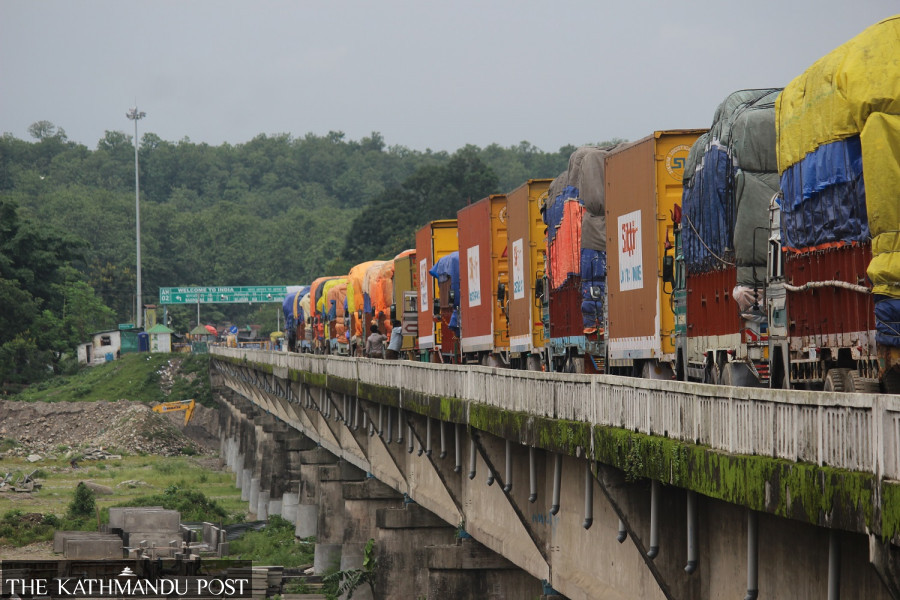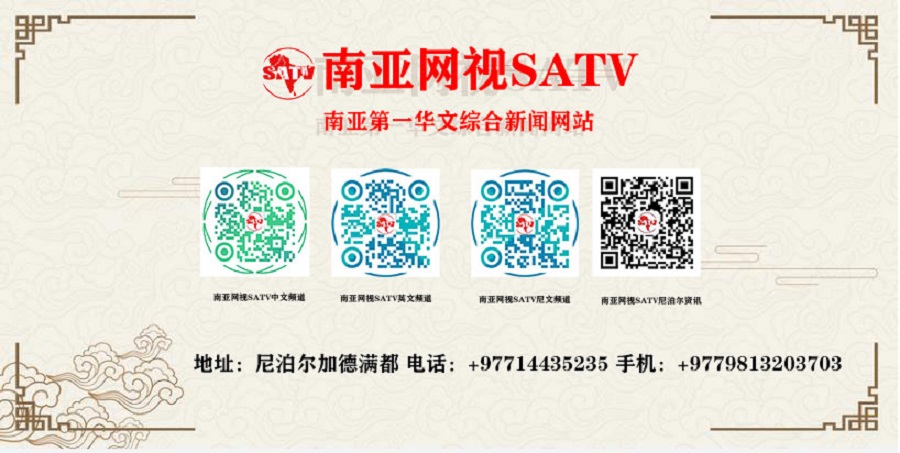
After Nepal promulgated its constitution on September 20, 2015, India reacted swiftly with a note—and then imposed a border blockade to express its displeasure. Cargo trucks from India stopped crossing the border into Nepal. Nepalis faced shortages of fuel, daily essentials and medicines.
The blockade lasted five months.
Nepalis came face to face with one of the harshest realities in modern times—their country was overly dependent on India, almost for everything.
The blockade came as a big blow for Nepal’s economy that was already reeling from the earthquakes that had hit the country a few months back, killing nearly 9,000 people.
According to the Central Bureau of Statistics, the economy in 2015-16 was sent into a tailspin with Nepal posting a meagre growth of 0.2 percent.
Nepal’s third-country trade was also deeply affected because of India being the transit route.
The central bank, in its study report, suggested that excessive reliance on India for almost everything was the reason for people’s sufferings and called for measures to diversify the country’s trade.
Six years down the line, not much has changed.
Nepal’s reliance on India continues to remain the same, or has even increased for that matter.
In the first five months of this fiscal year 2021-22, 60 percent of Nepal’s total imports were from India, according to Trade and Export Promotion Centre (TEPC).
Likewise, the southern neighbour received 81.76 percent of total exports of Nepal in these five months. India received 75.75 percent of Nepal’s exports in the fiscal year 2020-21, up from 71.75 percent in 2019-20, according to the TEPC.
The country’s overall trade with India was 63.7 percent of the total trade in the fiscal year 2014-15, a year before the blockade, central bank statistics show.
“We realised the risk of being over-reliant on a single country during the blockade. Even though certain measures were announced to make the country self-reliant and diversify trade, they were hardly implemented,” said Nara Bahadur Thapa, a former executive director of Nepal Rastra Bank, who produced a study report on the impact of India’s blockade as head of the research department at the central bank. “Market diversification means risk diversification too.”
The report titled “Impact of Unofficial Indian Embargo on Nepal” had pointed out that the country’s economy failed to withstand the shock of the third Indian blockade due to the country’s excessive dependence on its southern neighbour.
India had imposed blockade on Nepal previously in 1970 and 1988-89.
“Nepal did not learn lessons from the past two blockades and could not develop a self-reliant economy capable of bearing such shocks,” the report stated.
Thapa says six years later also, Nepal’s over-reliance on its southern neighbour has continued and is increasing.
In the wake of the border blockade, the then prime minister KP Sharma Oli made some moves to diversify Nepal’s trade and import goods from other countries via China.
During his visit to Beijing in March 2016, Oli signed a slew of agreements.
Nepal and China also signed a transit and transport agreement as per which Nepal could access seven sea and land ports in China for foreign trade. A protocol was signed in April 2019, but there has been no practical utilisation of the benefit so far.
There were also talks about linking China and Nepal through rail and road. The rail project has been in limbo.
One of the immediate deals that Nepal sought to sign with China was to import fuel, as pumps across Nepal saw serpentine queues of vehicles in the wake of the Indian border blockade. Fuel is one of the items for which Nepal depends completely on India.
Nepal Oil Corporation signed a memorandum of understanding with China National United Oil Corporation (PetroChina) in Beijing to supply petroleum products to Nepal. Based on the MoU, the northern neighbour supplied 1.2 million litres of fuels to tide Nepal over.
The plan to import fuel, however, soon turned out to be optics, as it reached nowhere.
After Nepal-India relations improved, supplies resumed. The plan to diversify trade with and via China lost priority.
“After fuel supply resumed from India, the issue of importing fuel from China took a backseat,” said Sushil Bhattarai, deputy managing director (marketing) of the corporation. “The lack of necessary physical infrastructure also hampered the plan.”
Nepal’s road connectivity with the north has been poor. Earthquakes destroyed the infrastructure at Tatopani border, the popular trade route between Nepal and China. The delay in reconstruction of facilities on the Chinese side by the north led to a halt in trade via the Tatopani border.
Another trade route that Nepal started using was via Rasuwagadhi. Normal trade restarted via the Kerung-Rasuwagadhi route in March 2016, but it was non-significant compared to Nepal's trade with India.
Then in December 2019, the coronavirus pandemic began, fuelling Nepal’s reliance on India again.
China took strong measures to control its border. There has been an ‘unofficial border blockade’ like situation and a limited number of cargo trucks have been entering Nepal from the north.
“The reasons behind Nepal’s failure to diversify our export is that we don’t have products, branding and marketing for the third countries,” said Thapa. “Nepal has also been unable to reap benefits from the duty free market access provided to Nepal in the foreign markets.”
For example, China does not impose any import duty on over 8,000 goods from Nepal under China’s commitment to providing duty-free treatment for the Least Developed Countries (LDCs). Nepal’s exports to China, however, have been poor. In the last fiscal year, Nepal exported goods worth Rs1 billion to China, and goods worth Rs 380 million during the first five months of the current fiscal year, according to the Trade and Export Promotion Centre.
The World Bank’s annual ‘Nepal Development Update 2021’ report released in April stated that Nepal has the potential of exporting 12 times its existing annual exports, with the highest potential of boosting exports to China.
Likewise, Nepal has been receiving duty-free market access for 77 types of garment products in the US since 2016 under its Trade Preference Program. In fact, the US had provided this facility to Nepal specifically by introducing a law after Nepal’s economy was devastated by the 2015 earthquakes. The programme will be valid until 2025.
But there has been hardly any progress in export growth for garments. For example, garment exports to the US in the fiscal year 2015-16 was Rs1.57 billion which declined to Rs1.31 billion in the fiscal year 2020-21, according to statistics of the Garment Association of Nepal.
Overall, the US, however, is the second largest export market for Nepal after India; goods worth Rs13.79 billion were exported to the US in the last fiscal year, according to the Trade and Export Promotion Centre.
Likewise, exports to the European Union have also not grown well even though Nepal enjoys a duty-free market access under its Generalised System of Preferences (GSP) system, official data show.
Experts say Nepal’s small export basket, failure to develop new products and ensure competitive prices and quality are among the factors that have prevented Nepal’s exports to third countries.
“We have failed in diversifying both products and the market because we don’t have products as per the market demands and we also cannot supply goods in large quantities,” said Chandra Ghimire, a former commerce secretary. “Our exports to the EU have been dismal because we cannot ensure the technical specifications that the EU has set. Lack of products as per the demands is also hindering exports to the US and disruption of trade through the land route has badly affected exports to China.”
He said Nepal has also failed to make necessary diplomatic efforts to boost exports to countries from where Nepal has been importing large quantities of goods.
“We have been importing goods from Brazil and Argentina, but our exports to these South American countries have remained negligible,” said Ghimire.
With trade with third countries suffering, Nepal has been forced to rely more on India for trade. Nepal's reliance on India for exports has continued at least in the last two decades and this has been aided further by the opportunity to export two products—soybean oil and palm oil.
“Exports of these items have increased by exploiting tariff advantages for Nepal and questions about sustainability of their exports to India remain,” said Posh Raj Pandey, a trade expert.
On the other hand, growing agricultural imports from India also contributed to Nepal’s increased reliance on India for trade.
On December 22, India’s State Minister for Agriculture Shobha Karandlaje wrote on Twitter that Nepal was the second largest export market for India’s pulses after the US in fiscal year 2020-21.
The budget for the fiscal year 2018-19 announced that Nepal would double the agriculture production in five years. The budget for the fiscal year 2019-20 announced that the country would be made self-reliant in fresh vegetables along with milk, fish and meat. Though the country has been heavily importing fresh vegetables, the government in March claimed that the country had become self-reliant in meat, egg, powder milk and butter to meet the minimum dietary needs of the country.
According to a study conducted by the National Planning Commission, the country imported agricultural goods worth over Rs200 billion in the fiscal year 2019-20, which could be produced within the country. Most agricultural goods came from India, according to the study titled ‘Status of Export and Import of Agriculture Goods.”
“We failed to substitute imports of agricultural goods though a policy of making the country self-reliant in a number of agricultural goods was announced through annual budgets,” said Thapa.
According to experts, Nepal’s currency pegging and its stable exchange rate with India have also contributed to increased import from the southern neighbour, even though it has also saved the country from the impact of external volatile currency markets.
Nepal’s currency heavily devalued against the US dollar over the last three decades—from less than Rs50 per dollar in the early 1990s to over Rs119 now. However, it has maintained a stable exchange rate with India at Rs1.6 for INR 1 since 1993.
“As a result, goods imported from third countries became expensive while those from India became cheaper, contributing to Nepal’s increased imports from the southern neighbour,” said Pandey.
Officials said that the country’s overreliance on India was natural as doing business with India is easier compared to other countries.
Narayan Prasad Regmi, spokesperson for the Ministry of Industry, Commerce and Supplies, said that as doing business with India was easier and profitable, people mostly did business with the southern neighbour and the country's trade was heavily skewed towards it.
“Supply disruption caused by coronavirus may also be the reason why trade with third countries suffered,” he said.
In the 1980s, Nepal-India trade was largely even. The country enjoyed favourable trade relations in the 1980s as around 24 percent of Nepal’s total imports would be from India and around 28 percent of its total exports would be to the southern neighbour, according to a central bank study.
Nepal’s reliance on India trebled in the decade of 2000 as the country’s industrial sector suffered amid the Maoist conflict. Growing domestic and foreign migration resulted in the import of more goods.
The country relied further on its southern neighbour in the last decade, according to central bank statistics.
Experts fear that Nepal’s trade dependence on India could further increase after it gets out of the LDC status to become a developing country in 2026, as the country will lose the preferential treatment provided to LDCs in China, European Union and other countries.
“There is obviously a risk of the country losing the market in Europe and other countries after duty-free market access is denied,” said Pandey. “We have time to enhance our capability. But we need to act now.”













